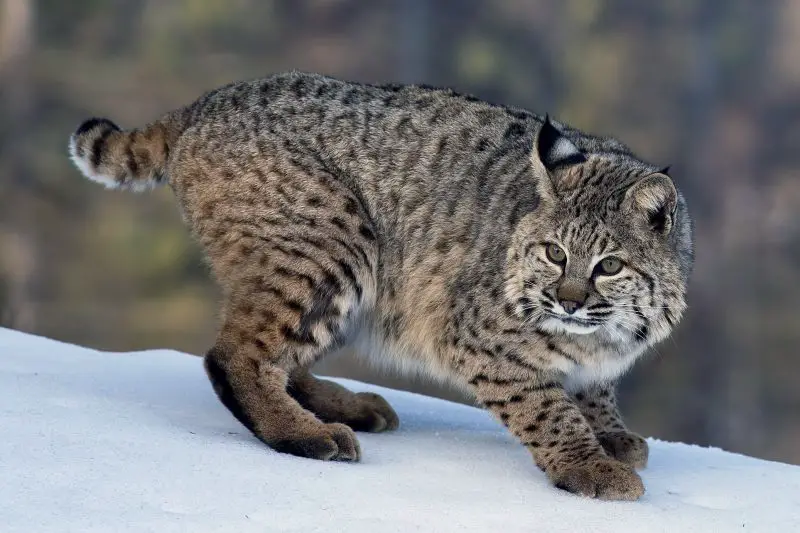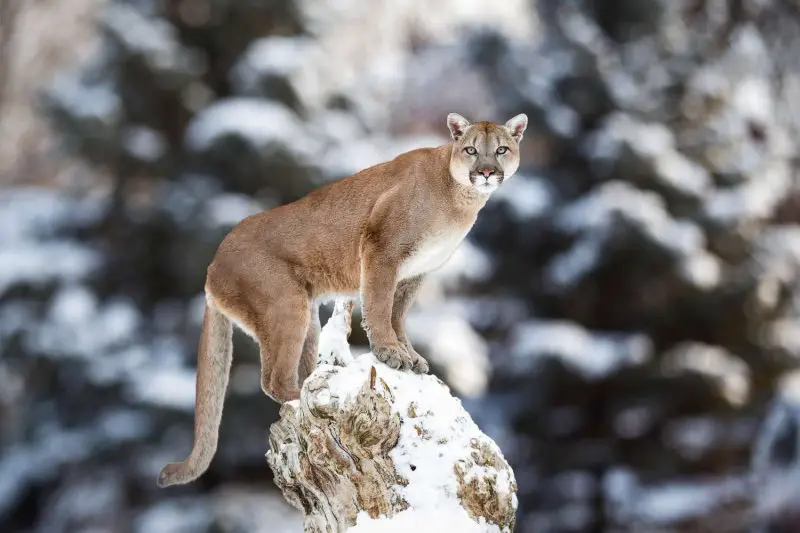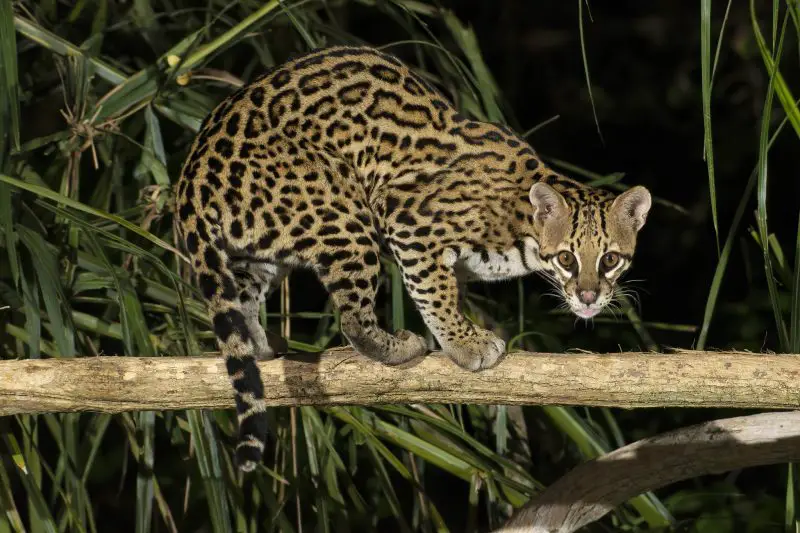Texas is home to a fascinating variety of wild cats, ranging from the elusive bobcat to the majestic mountain lion. Each species plays a vital role in maintaining the balance of local ecosystems.
While some wild cats are widespread, like the bobcat, others are extremely rare, such as the ocelot, which is restricted to the southernmost regions of the state. Observing them requires patience and respect for their natural habitats.
This guide explores the three main types of wild cats in Texas, offering detailed identification tips, habitat information, behavior insights, and fun facts for wildlife enthusiasts and photographers.
Different Types of Wild Cats Found in Texas
Bobcat (Lynx rufus)

The bobcat is the most widespread wild cat in Texas, found in nearly every county across the state. Medium in size, it stands about 18–24 inches at the shoulder and weighs between 15–35 pounds, with males generally larger than females. Its most recognizable features are the short “bobbed” tail, tufted ears, and a spotted coat that ranges from grayish to reddish brown. These markings help camouflage the cat in forests, grasslands, and even scrubby desert terrain.
In terms of behavior, bobcats are primarily solitary and territorial, marking their ranges with scent to ward off rivals. They are crepuscular, meaning most active during dawn and dusk, but in Texas’s hotter regions they may also hunt at night. Bobcats are agile climbers and swimmers, though they rarely rely on water environments. They have adapted well to both rural wilderness and suburban edges, often roaming near farms and small towns.
Bobcats are opportunistic feeders and skilled hunters, preying on rabbits, rodents, birds, and occasionally small deer. Their hunting style relies on stealth and short bursts of speed, pouncing with precision after stalking prey. In agricultural areas of Texas, they also benefit farmers by controlling rodent populations, although they sometimes clash with people when attacking poultry. Despite being predators, bobcats themselves may fall victim to larger carnivores or human hunting.
A fun fact about bobcats is that they can leap as far as 10 feet in a single bound, an ability that helps them capture fast-moving prey. In Texas, their population remains stable and robust, making them one of the most commonly sighted wild cats. Their adaptability to diverse environments explains why they thrive everywhere from the pine forests of East Texas to the deserts of West Texas.
Mountain Lion (Puma concolor)

The mountain lion, also known as cougar, panther, or puma, is the largest wild cat still roaming Texas. Adults typically measure between 5–8 feet long, including the tail, and weigh 80–150 pounds, with males significantly heavier than females. They are tawny to grayish in color with lighter underbellies, and unlike bobcats, they have a long, powerful tail that aids balance when leaping across rocky terrain. Their size and stealth make them apex predators in Texas ecosystems.
These cats are elusive and prefer to avoid humans, though they require vast territories to survive. Mountain lions in Texas are mostly concentrated in the western half of the state, particularly in rugged areas such as Big Bend National Park, the Trans-Pecos, and parts of the Hill Country. They thrive in rocky canyons, brushlands, and desert mountains, where cover is plentiful for stalking prey. Males can roam territories exceeding 100 square miles, making them one of the most wide-ranging carnivores in North America.
Mountain lions feed primarily on white-tailed deer and mule deer, but they also hunt javelinas, rabbits, raccoons, and even livestock if natural prey is scarce. Their hunting strategy involves stealthy stalking followed by a powerful leap to the neck of their prey, delivering a fatal bite. Because of their role in controlling deer populations, they help maintain ecological balance, although their presence can spark conflicts with ranchers.
A fun fact about mountain lions is that they can leap horizontally up to 40 feet in a single bound, making them one of the most powerful jumpers of all mammals. In Texas, they are not legally classified as a protected species, which means landowners may hunt them to protect livestock. Despite this, mountain lions remain an iconic symbol of Texas wilderness, representing strength and resilience in the rugged landscapes they call home.
Ocelot (Leopardus pardalis)

The ocelot is one of the rarest wild cats in Texas and also one of the most striking in appearance. Smaller than a bobcat, it weighs between 15–35 pounds and has a sleek, elongated body with short legs. Its coat is golden to reddish-tan, patterned with dark rosettes, spots, and stripes, making it one of the most beautifully marked cats in the world. Unlike bobcats and mountain lions, the ocelot has a long ringed tail and rounded ears without tufts.
In Texas, ocelots are restricted mostly to the southernmost tip of the state near the Rio Grande Valley. They prefer dense thorn scrub and brushland habitats, where their patterned coats provide perfect camouflage. Historically, ocelots roamed across much of South Texas, but habitat destruction and urban development have confined them to just a few protected areas, including Laguna Atascosa National Wildlife Refuge and nearby ranchlands. Fewer than 100 individuals are believed to survive in the state today.
Ocelots are primarily nocturnal hunters, feeding on small mammals, birds, reptiles, and amphibians. Their stealth allows them to sneak through dense brush before ambushing prey. Unlike the mountain lion, ocelots rarely take down large animals, instead preferring rodents, rabbits, and ground-dwelling birds. Their presence indicates a healthy ecosystem, but they face threats from vehicle collisions, habitat loss, and competition with bobcats.
A fun fact about ocelots is that their distinctive coats were once so prized in the fur trade that populations across the Americas plummeted. Today, they are federally endangered in the U.S., making them one of the most protected cats in Texas. Their secretive lifestyle and rarity mean that most Texans will never see one in the wild, yet they remain an important symbol of conservation efforts in the state.
Comparison of Wild Cats in Texas
Feature |
Bobcat (Lynx rufus) |
Mountain Lion (Puma concolor) |
Ocelot (Leopardus pardalis) |
|---|---|---|---|
Size & Weight |
18–24 in tall; 15–35 lbs |
5–8 ft long incl. tail; 80–150 lbs |
2.5–3.5 ft long; 15–35 lbs |
Appearance |
Short “bobbed” tail, tufted ears, spotted gray to reddish coat |
Tawny coat, muscular body, long tail |
Golden coat with black rosettes, long tail |
Behavior |
Solitary, crepuscular, territorial |
Solitary, secretive, wide-ranging |
Nocturnal, secretive, territorial |
Diet & Hunting |
Rabbits, rodents, birds, sometimes small deer |
Primarily deer, also javelinas, rabbits, livestock |
|
Habitat |
Forests, grasslands, deserts, suburban edges |
Rugged canyons, brushlands, mountains |
Dense thorn scrub, brushland |
Distribution in Texas |
Found across all regions of Texas |
Mostly western Texas (Big Bend, Trans-Pecos, Hill Country) |
Southern tip near Rio Grande Valley |
Fun Fact |
Can leap 10 feet in a single bound |
Can leap up to 40 feet horizontally |
Once heavily hunted for its fur, now endangered |
Best Time and Places to Observe Wild Cats in Texas
Bobcat (Lynx rufus)
Bobcats are most active during dawn and dusk, so early mornings or late evenings offer the best chances of spotting them. They are widespread, so observation is possible throughout forests, grasslands, and brushy areas across Texas, including state parks and wildlife refuges. Look for areas with abundant prey, such as rabbits and rodents, and watch quietly from a distance to avoid disturbing them.
Mountain Lion (Puma concolor)
Mountain lions are highly elusive and primarily nocturnal, though dawn and dusk sightings are occasionally reported. The best locations in Texas are remote, rugged regions like Big Bend National Park, the Trans-Pecos region, and parts of the Hill Country. Hikers and wildlife enthusiasts should maintain safety precautions, stay on trails, and use binoculars to scan ridges and valleys for signs such as tracks or scrapes.
Ocelot (Leopardus pardalis)
Ocelots are strictly nocturnal, so nighttime observation is necessary. They are extremely rare and mostly restricted to the southern tip of Texas near the Rio Grande Valley, particularly in protected areas such as Laguna Atascosa National Wildlife Refuge and nearby ranchlands. Observers must remain very quiet and use infrared cameras or guided wildlife tours to increase the likelihood of sightings without disturbing their fragile population.
FAQs About Wild Cats in Texas
What types of wild cats are found in Texas?
Texas is home to three main wild cat species: the bobcat (Lynx rufus), the mountain lion (Puma concolor), and the ocelot (Leopardus pardalis). Bobcats are widespread across the state, mountain lions inhabit the western and rugged regions, and ocelots are extremely rare, primarily found near the Rio Grande Valley. Historically, jaguars were also present in southern Texas, but they are no longer established residents.
Are wild cats in Texas dangerous to humans?
Wild cats are generally not a threat to humans. They are secretive, avoid human contact, and are more likely to flee than attack. Mountain lions, being the largest, have the potential to be dangerous if cornered, but encounters are extremely rare. Bobcats and ocelots are small to medium in size and pose virtually no risk, though they may defend themselves if threatened.
What is the best time to see wild cats in Texas?
The best time to observe wild cats depends on the species. Bobcats are most active during dawn and dusk, mountain lions are primarily nocturnal but sometimes active at dawn or dusk, and ocelots are strictly nocturnal. Observing them often requires patience, quiet, and sometimes night-vision equipment or guided wildlife tours.
Where can I see wild cats in Texas?
Bobcats can be seen throughout Texas, especially in forests, grasslands, and wildlife refuges. Mountain lions are mostly in western Texas, including Big Bend National Park, the Trans-Pecos region, and Hill Country. Ocelots are restricted to southern Texas, near the Rio Grande Valley in protected areas like Laguna Atascosa National Wildlife Refuge. Wildlife enthusiasts should use binoculars and maintain a safe distance.
What do wild cats in Texas eat?
Wild cats are carnivorous predators. Bobcats feed on rabbits, rodents, birds, and occasionally small deer. Mountain lions primarily hunt deer, javelinas, and rabbits, and may sometimes prey on livestock. Ocelots eat smaller prey such as rodents, rabbits, birds, and reptiles. Their diet depends on availability and habitat, and they play a crucial role in controlling prey populations.
How can I identify different wild cats in Texas?
Identification depends on size, coat pattern, and tail. Bobcats are medium-sized with a short “bobbed” tail and spotted coat. Mountain lions are large, tawny-colored cats with long tails and muscular bodies. Ocelots are smaller, with golden coats covered in dark rosettes and a long ringed tail. Observers should also note behavior and habitat preferences when trying to identify them in the wild.






